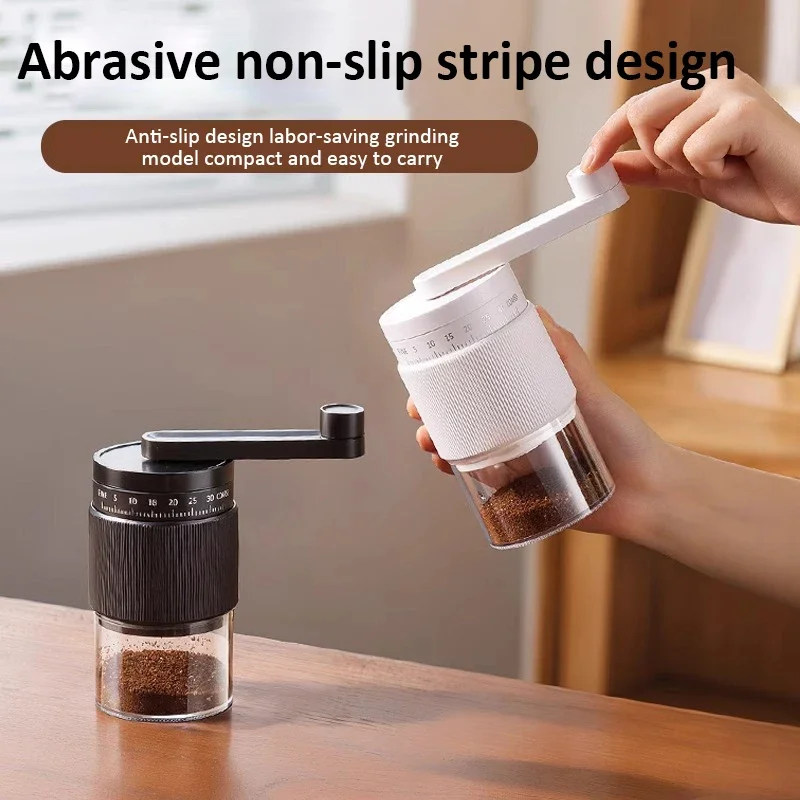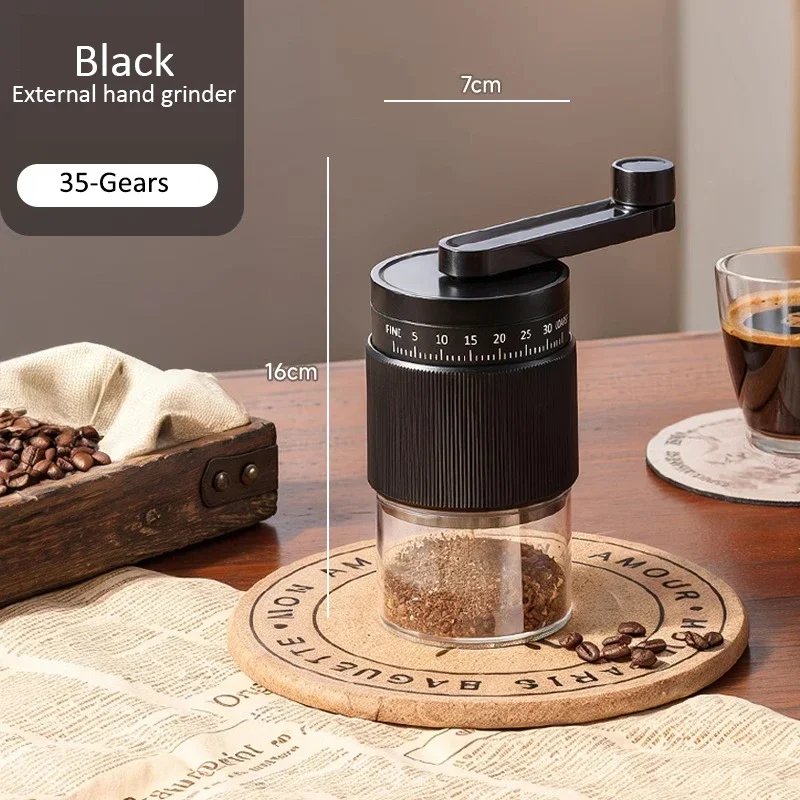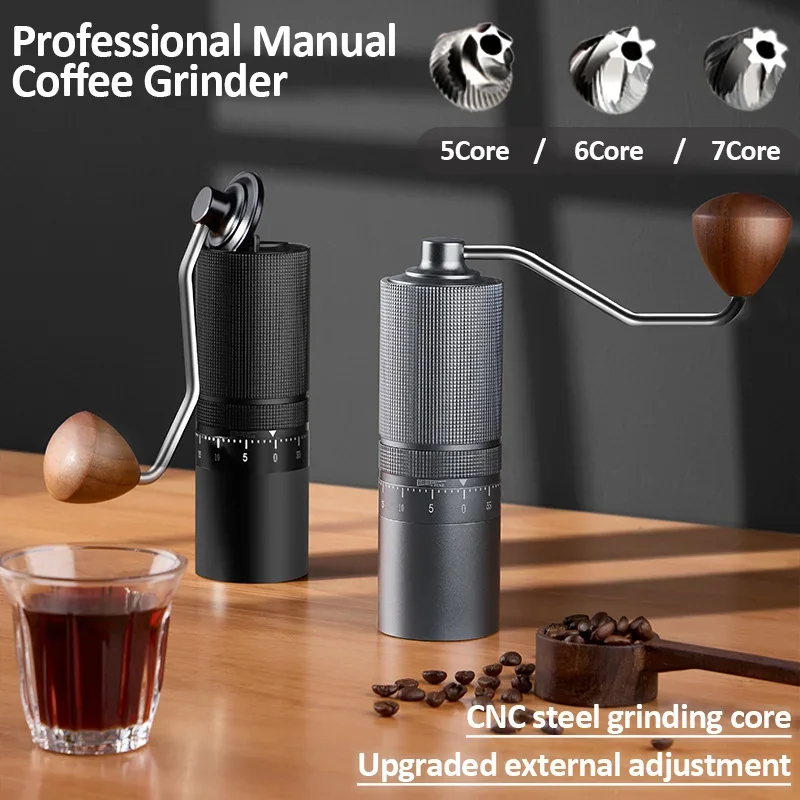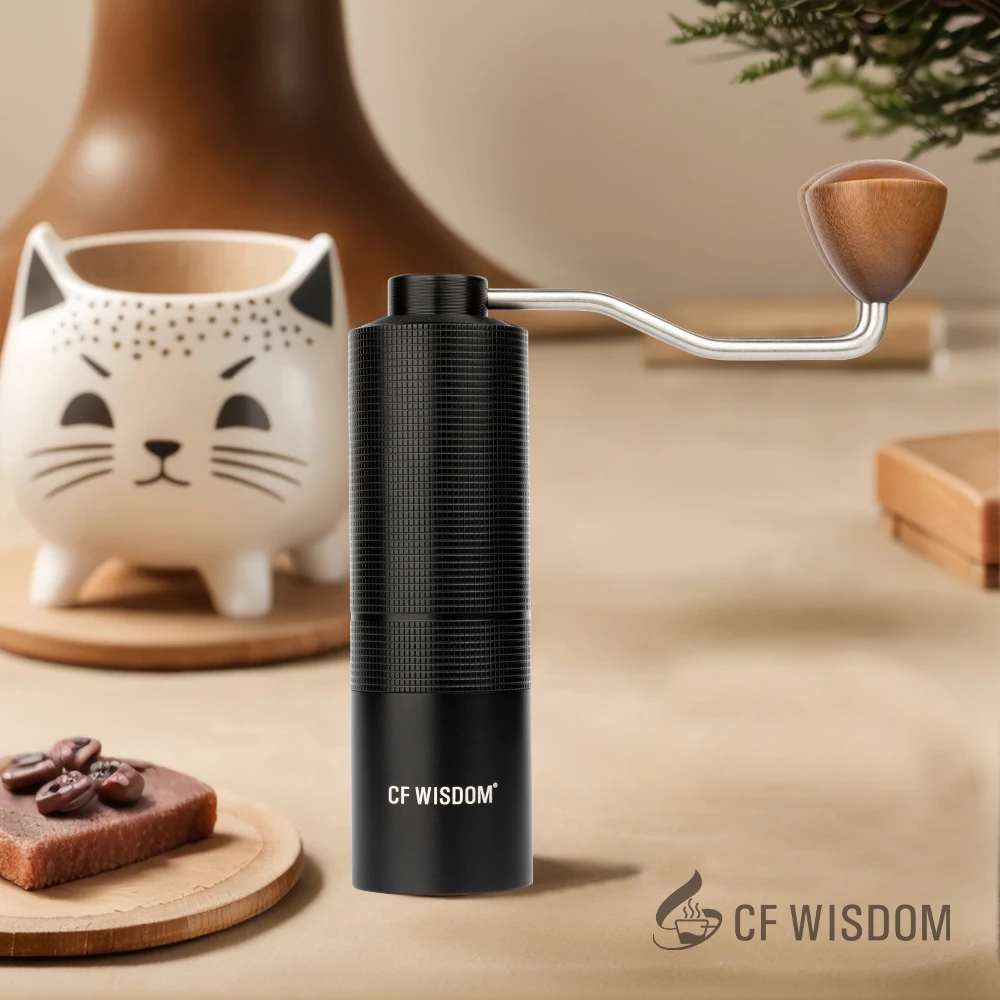Introduction: Understanding the Importance of Grind Size in Espresso Extraction
The perfect espresso shot is a delicate balance of art and science, with grind size playing a pivotal role in achieving that ideal cup. When you adjust your grind size, you directly control how quickly water flows through your coffee grounds, ultimately determining your extraction time. The gold standard for espresso extraction typically ranges between 20-30 seconds, which produces a balanced flavor profile that’s neither too sour nor too bitter.
Many home baristas struggle with inconsistent shots, finding themselves trapped in a cycle of unpredictable results. This inconsistency often stems from improper grind adjustment—a concept baristas call “dialing in” your grinder. The basic extraction theory is straightforward: too fine a grind creates too much resistance, resulting in slow, bitter shots; too coarse a grind allows water to rush through, creating fast, sour shots.
In this guide, we’ll walk through practical steps to help you adjust your grind size for perfect espresso shot timing. Using the industry standard parameters of 18g of coffee yielding approximately 36g of espresso in 25-30 seconds as our benchmark, we’ll help you achieve consistently delicious results. Understanding the fundamentals of fine-tuning espresso grind size is essential for creating balanced, flavorful shots every time.
The Science of Extraction: How Grind Size Affects Your Shot
Think of water flowing through your coffee grounds like water moving through different materials. Coarse grounds are like pebbles—water passes between them quickly with minimal resistance. Fine grounds are more like sand—water struggles to find a path through, creating higher resistance and slower flow.
This relationship between grind size and water flow comes down to surface area. Finer grounds have significantly more surface area exposed to water, allowing for more efficient extraction but requiring more pressure to push water through. This increased contact time between water and coffee results in more compounds being extracted.
When your grind is too coarse, water rushes through too quickly (under-extraction), resulting in sour, weak, and watery espresso. Conversely, when your grind is too fine, water moves too slowly (over-extraction), creating bitter, harsh flavors that mask the coffee’s natural characteristics.
While factors like dose weight, tamping pressure, and water temperature all influence extraction, grind size remains the primary variable affecting flow rate when these other elements remain constant. The physics of how coffee grind affects pressure flow demonstrates that even tiny adjustments to grind size can dramatically change extraction time, pressure, and ultimately, flavor.
Essential Equipment for Precise Grind Adjustment
To achieve consistent espresso extraction, you’ll need:
- Quality burr grinder: The foundation of precise adjustment. Stepless grinders offer infinite adjustment possibilities, while stepped grinders provide fixed increments. Either can work well, though stepless allows for more precision.
- Digital scale (accurate to 0.1g): Essential for consistent dosing, which directly affects extraction time.
- Timer: Either built into your espresso machine or a separate device to track extraction duration.
- Appropriate portafilter and basket: Different basket sizes and designs affect flow rate and extraction.
- Distribution tools (optional): Helps ensure even distribution of grounds for consistent extraction.
- Fresh coffee beans: Coffee degasses over time, affecting how water flows through the grounds. Beans that are too fresh or too old can produce inconsistent results.
The difference between blade and burr grinders cannot be overstated—blade grinders chop beans randomly, creating uneven particles that extract at different rates. Only burr grinders can produce the consistent particle size needed for predictable espresso extraction. Our selection of manual coffee burr grinders offers various options designed specifically for achieving the precision needed for espresso.
Starting Point: Establishing Your Baseline Grind Setting
Before making adjustments, you need a starting point that serves as your baseline:
Select an initial grind setting based on your grinder type. Many espresso-capable grinders have a recommended espresso range—start in the middle of this range.
Set up your workspace methodically, with everything you need within reach for systematic adjustment.
Measure your dose consistently using a scale. The industry standard for a double shot is 18-20g, though this may vary slightly depending on your basket size.
Apply consistent tamping pressure. Variations in tamping can affect flow rate independently of grind size. Aim for firm, level pressure around 30 pounds—roughly the weight of leaning with your body weight on the tamper.
Purge your grinder between adjustments to remove any retained grounds from previous settings.
Record your results in a notebook or app, noting grind setting, dose weight, shot time, yield, and taste observations.
Finding the perfect espresso grind size often requires multiple attempts, but establishing this baseline will save you time and coffee in the long run.
The Step-by-Step Process for Dialing In Your Grind
Pull your first shot using your baseline grind setting. Start your timer when you begin brewing and stop it when you reach your target yield (typically 36g for a double shot with an 18g dose).
Measure both time and yield precisely. If your shot runs faster than 20 seconds or slower than 30 seconds, you’ll need to adjust your grind.
Evaluate the taste of your espresso. Under-extracted shots taste sour, lack sweetness, and finish quickly. Over-extracted shots taste bitter, harsh, and leave a lingering unpleasant aftertaste.
Determine your adjustment direction:
* If your shot was too fast (under 20 seconds): Make your grind finer
* If your shot was too slow (over 30 seconds): Make your grind coarserMake incremental adjustments. Most grinders require small adjustments—usually just 1-2 “clicks” or a tiny dial movement. Dramatic changes can overshoot your target.
Test your adjustment by pulling another shot, again measuring time and yield precisely.
Repeat the process until you achieve the desired extraction time of 20-30 seconds.
Fine-tune by taste. Once you’re in the correct time range, make minor adjustments based on flavor. If it’s still slightly sour, go a touch finer; if slightly bitter, a touch coarser.
Remember that the goal is balanced flavor, not just hitting a specific time. The time range serves as a guideline, but your taste preferences are the ultimate judge.

Using a precision manual grinder can give you excellent control over these adjustments, allowing for the small incremental changes needed for espresso.
Troubleshooting: Common Grind and Shot Timing Issues
Even with careful adjustment, you may encounter these common issues:
Shots running too fast despite fine grind: This usually indicates channeling, where water finds paths of least resistance through your puck. Improve your distribution technique and ensure even tamping.
Inconsistent shot times with the same settings: Check for inconsistent dosing or tamping. Even small variations can significantly impact flow rate.
Grinder drift: Over time, burrs may shift slightly from their original position. Regular cleaning and occasional recalibration help maintain consistency.
Seasonal/humidity changes: Coffee beans absorb moisture from humid environments and become drier in arid conditions, requiring grind adjustments as seasons change.
Dose variations: If your dose fluctuates even slightly, your shot timing will vary even with consistent grind settings. Always weigh your dose.
Bimodal particle distribution: Lower quality grinders sometimes produce both fine and coarse particles simultaneously, making consistent extraction difficult.
Grinder retention: Old grounds mixing with fresh ones can cause inconsistency. “Single dosing” techniques or purging between adjustments can help.
Finding comprehensive solutions for troubleshooting espresso grind issues can save you both coffee and frustration while working toward consistent shots.
Beyond the Grind: Other Variables Affecting Shot Timing
While grind size is crucial, several other factors influence extraction time:
Coffee Freshness
Coffee reaches peak flavor 7-14 days after roasting for espresso. Too fresh, and excessive CO2 causes inconsistent extraction; too old, and oils oxidize, affecting flow rate.
Bean Variety and Roast Level
Darker roasts are more soluble and generally require coarser grinds than lighter roasts. Different bean varieties also have different density and hardness, affecting how they grind and extract. The relationship between espresso grind size and light versus dark roasts requires specific adjustments for optimal extraction.
Temperature and Pressure
Higher temperatures increase extraction efficiency, potentially requiring coarser grinds. Variations in machine pressure directly affect flow rate and extraction time.
Water Chemistry
Mineral content in water affects extraction and can build up scale that changes machine pressure over time. Using filtered water with appropriate mineral content provides more consistent results.
Basket Design
Different basket designs (straight-wall, tapered, precision) influence flow rate and require slightly different grind adjustments to achieve optimal extraction.
Tamping Technique
Inconsistent or uneven tamping creates channels for water to flow through more quickly, regardless of grind size.
Fine Adjustment Hand Grinder, Precision Manual Grinder, Travel Coffee Grinder
Price range: $185.11 through $494.63 Select options This product has multiple variants. The options may be chosen on the product pageHand Burr Grinder, Hand Crank Coffee Grinder, Manual Espresso Grinder, Portable Coffee Grinder
Price range: $262.72 through $300.22 Select options This product has multiple variants. The options may be chosen on the product pageManual Burr Mill, Manual Coffee Grinder Stainless Steel, Manual Coffee Mill Grinder, Mechanical Coffee Grinder
Price range: $127.26 through $130.32 Select options This product has multiple variants. The options may be chosen on the product pageHand Burr Grinder, Manual Coffee Grinder Stainless Steel, Precision Manual Grinder
Price range: $183.64 through $187.52 Select options This product has multiple variants. The options may be chosen on the product page
Fine-Tuning Your Palate: Tasting to Adjust Your Grind
Learning to taste extraction differences is essential for making appropriate grind adjustments. Develop your palate by focusing on these key indicators:
Under-extracted espresso (too coarse, too fast) typically presents:
* Sharp, piercing acidity
* Lack of sweetness
* Thin body
* Sour, lemony, or vinegar-like notes
* Quick finish with little aftertaste
Properly extracted espresso displays:
* Balanced sweetness and acidity
* Rich, syrupy body
* Complex flavor development
* Pleasant lingering finish
* Harmonious blend of flavor notes from the bean
Over-extracted espresso (too fine, too slow) reveals:
* Diminished acidity
* Overwhelming bitterness
* Dry, astringent mouthfeel
* Harsh, burnt, or medicinal notes
* Unpleasant, lingering aftertaste
It’s worth noting that within the “proper” extraction range, you may prefer shots that lean slightly toward either end of the spectrum. Understanding the detailed connections between grind size adjustments and flavor profiles allows you to tailor your espresso to your personal preferences.

Advanced Techniques: Precision Grind Adjustments for Espresso
Once you’ve mastered the basics, these advanced techniques can help you achieve even better results:
Micro-adjustments: Make extremely small changes to your grinder setting—sometimes just a fraction of a normal adjustment increment. Some precision grinders allow for very fine adjustment capability.
Particle distribution analysis: While professional tools exist, even examining your grounds under a magnifying glass can help you evaluate consistency.
Single dosing: Measuring individual doses before grinding eliminates inconsistencies caused by grinder hoppers and allows for easier switching between different coffees.
WDT (Weiss Distribution Technique): Using a fine tool (like a dissected paperclip) to gently stir and break up clumps in the ground coffee before tamping dramatically improves extraction uniformity.
RDT (Ross Droplet Technique): Adding a tiny drop of water to whole beans before grinding reduces static and improves dose consistency.
Temperature surfing: Learning to time your shot with your machine’s heating cycle ensures consistent brewing temperature from shot to shot.
Salami shots: Collecting espresso in several small cups during extraction allows you to taste different phases of the shot, helping identify extraction issues.
Many enthusiasts find that precision grind adjustment techniques are the key difference between good and exceptional espresso.
Can I Use the Same Grind Setting for Different Espresso Machines?
Different machines typically require different grind settings even when using the same coffee. This variation occurs due to:
Pressure differences: While 9 bars is standard, actual operating pressure varies between machines. Lever machines create different pressure profiles than pump machines.
Basket design: Different manufacturers use varying hole patterns, depths, and diameters that affect flow restriction.
Water distribution: How water hits the coffee puck varies by machine design, affecting how evenly extraction occurs.
Temperature stability: Machines with better temperature control may extract more efficiently, requiring slightly coarser grinds.
When switching between machines, start with your existing grind setting but expect to make adjustments. Understanding the principles of adapting grind settings across different machines helps you transfer your skills between different equipment setups.
Does Grinder Calibration Affect Shot Timing?
Proper grinder calibration significantly impacts your ability to achieve consistent shot timing. Key considerations include:
Burr alignment: Misaligned burrs produce inconsistent particle sizes, leading to uneven extraction regardless of grind setting.
Signs of poor calibration: Look for audible metal-on-metal noise, visibly uneven grounds, or unexplained inconsistency in shot times despite consistent technique.
Worn burrs: Over time, grinding surfaces dull, producing more fines and inconsistent particles. If your shots become increasingly unpredictable despite good technique, burr replacement may be necessary.

Quality manual espresso grinders are designed with precision alignment systems that maintain consistency over time, resulting in more predictable extraction.
Conclusion: Mastering the Art of Grind Adjustment
Adjusting your grind size for perfect espresso timing is a skill that improves with practice and patience. Remember that small, systematic changes yield the best results—dramatic adjustments almost always lead to overshooting your target.
Start with the basics: establish your baseline, make incremental adjustments based on shot time, taste your results, and refine accordingly. Document your process so you can replicate successful settings and learn from less successful ones.
While the 20-30 second extraction window serves as a useful guideline, your personal taste preferences should ultimately guide your adjustments. Some coffees shine with slightly faster or slower extractions, and your perfect shot may fall just outside the standard parameters.
With consistent practice, you’ll develop an intuitive understanding of how grind adjustments affect your espresso, allowing you to troubleshoot issues quickly and achieve delicious results reliably. The journey toward espresso perfection is ongoing, but mastering grind adjustment gives you the fundamental tool needed to create exceptional coffee at home.







